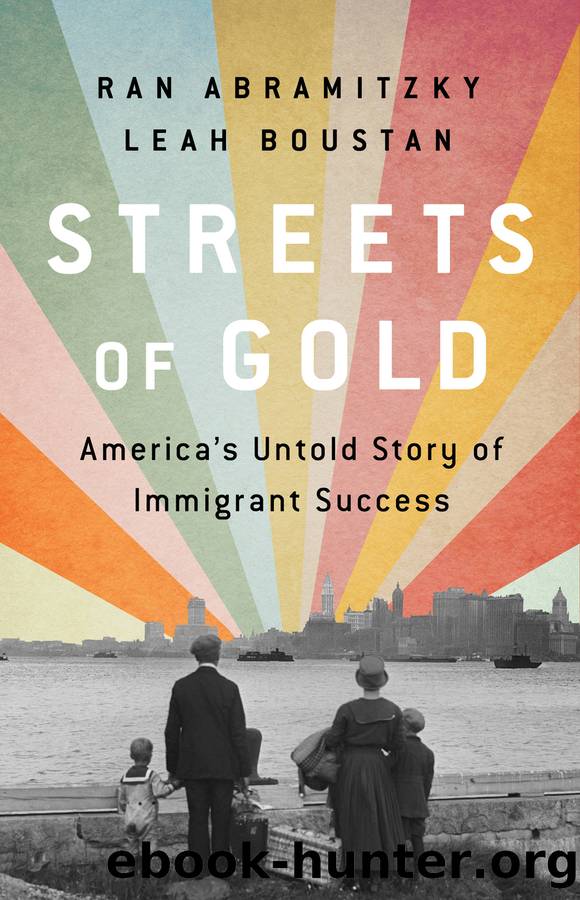Streets of Gold by Ran Abramitzky

Author:Ran Abramitzky [Ran Abramitzky and Leah Boustan]
Language: eng
Format: epub
Publisher: PublicAffairs
Published: 2022-05-30T00:00:00+00:00
IMMIGRANT NEIGHBORHOODS
Speaking English allows immigrants to build cultural ties with friends, neighbors, and coworkers who were born in the United States or who immigrated from elsewhere. One sign of being socially integrated is living outside of an ethnic neighborhood. What we find in the data is that immigrants are just as likely to live outside of ethnic neighborhoods today as in the past.
Immigrants live in many different circumstances. Some immigrants live in outlying suburbs where only a few other fellow residents are born abroad, some live in mixed neighborhoods, and still others live in heavily immigrant enclaves, in which perhaps 75 percent of the residents are also born outside the United States. One summary number that captures the most common neighborhood experience for immigrants is called the âisolation index.â The isolation index tells us, for the representative immigrant, what percentage of his or her neighbors were also born abroad. The isolation index considers all of those cases and constructs an average across them, providing us with one summary number.
Hereâs one striking fact based on the isolation index: immigrant integration was nearly identical in 2020 to the degree of residential integration a century ago. In 1920, the immigrant isolation index stood at 45 percent. A century later, the index value again sits between 45 and 50 percent.34 These values mean that, in both eras, the typical immigrant lived in a neighborhood in which around half of their neighbors were also born abroad. If immigrants were equally spread throughout all neighborhoods, we would expect that figure to be closer to 15 percent. So immigrants clearly live in clustered areas, but no more so now than in the past.
With historical census data, we can get an even more precise snapshot of who lived next to whom. Census takers used to go door-to-door to fill out the survey, so the households listed next to each other on a census manuscript were often next-door neighbors.35 One measure of segregation is living near others from abroad. By this measure, almost every immigrant group has had the dubious distinction of being the most segregated group at some point in the past. For example, in 1860, Irish immigrants living in industrial cities like Lowell and Lawrence, Massachusetts, were the most segregated immigrant group in the country. In 1880, this distinction went to Chinese immigrants in San Francisco. By 1910, it was the Italians in Providence, Rhode Island, and in 1930, it was Mexicans in California and Texas.
Many immigrant neighborhoods form because immigrants choose to live close to others from their home country, seeking help from each other if they need it. Immigrant enclaves can grow up around a few immigrants who choose a neighborhood simply because it is close to work or because housing is plentiful, rather than because of the presence of other immigrants. These pioneers can act as a magnet, attracting fellow immigrants to settle nearby.
Flushing, Queens, a vibrant business district and large residential community, is the heart of Indian American life in New York City today.
Download
This site does not store any files on its server. We only index and link to content provided by other sites. Please contact the content providers to delete copyright contents if any and email us, we'll remove relevant links or contents immediately.
| ASVAB | GED |
| GRE | NCLEX |
| PRAXIS | SAT |
| See more | Flash Cards |
| Study Guides | Study Skills |
| Workbooks |
Talking to Strangers by Malcolm Gladwell(13225)
The Compound Effect by Darren Hardy(8812)
Tools of Titans by Timothy Ferriss(8219)
Wonder by R. J. Palacio(8011)
The Lover by Duras Marguerite(7831)
A Court of Wings and Ruin by Sarah J. Maas(7653)
The Circle by Dave Eggers(7038)
Deep Work by Cal Newport(6881)
Kaplan MCAT General Chemistry Review by Kaplan(6867)
To All the Boys I've Loved Before by Jenny Han(5776)
Wiseguy by Nicholas Pileggi(5672)
The Body: A Guide for Occupants by Bill Bryson(4975)
1,001 ASVAB Practice Questions For Dummies by Powers Rod(4453)
Eat That Frog! by Brian Tracy(4436)
Cracking the GRE Premium Edition with 6 Practice Tests, 2015 (Graduate School Test Preparation) by Princeton Review(4227)
Pre-Suasion: A Revolutionary Way to Influence and Persuade by Robert Cialdini(4151)
Barron's AP Biology by Goldberg M.S. Deborah T(4100)
ACT Math For Dummies by Zegarelli Mark(3996)
Alive: The Story of the Andes Survivors by Piers Paul Read(3970)
